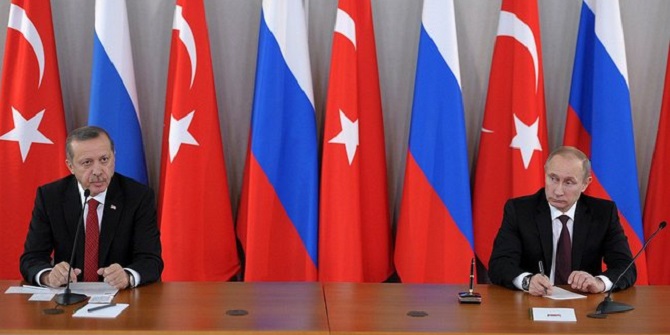In Predator Empire: Drone Warfare and Full Spectrum Dominance, Ian G. R. Shaw examines the history and development of US drone warfare, with a particular focus on deterrritorialisation and enclosure as key concepts in the emergence of what he terms the ‘Predator Empire’. Courteney J. O’Connor finds this an impressive and timely text that will be of interest to anyone concerned with the evolving relationship between technology and security.
Predator Empire: Drone Warfare and Full Spectrum Dominance. Ian G. R. Shaw. University of Minnesota Press. 2016.
Predator Empire: Drone Warfare and Full Spectrum Dominance examines prima facie the history and evolution of US drone warfare, and the expansion of that use beyond traditional conflict zones. Ian Shaw analyses the meaning and intent behind the concept of full spectrum dominance as military doctrine. What we now see with regards to ‘mission creep’ of the Predator and other drones has resulted in what Shaw terms the ‘Predator Empire’. This new ‘Empire’ is founded on the existential force of technology in modern life: technology, such as drones, is changing how human beings interact and relate not only with each other, but also with the world at large. We are seeing technology transform the patterns of life as it is undertaken, becoming an agent of change as opposed to humans making decisions and then using technology to support them. Life is arguably becoming determined by technology: how it works, the effect it has on us and what can be done with it.
Per Shaw, both a driving force and a result of the Predator Empire is the deterritorialisation of conflict. Where once a warzone was fairly well delineated and (crucially) enclosed, the book quotes former US Secretary of Defense Donald Rumsfeld in noting that ‘the entire world is a battlespace’ (120). The Predator Empire is a global, and globalising, phenomenon.
The idea of enclosure is a concept that is threaded through the entire text. Shaw traces the beginning of the enclosure of human societies in specific areas back to the loss of the Commons in England, when landlords emerged and began erecting fences and charging rents. As Shaw further examines the evolution of enclosure, it becomes apparent that it is inextricably linked with the development of, and increasing reliance on, technology. We have become a technologically and digitally enclosed society. The electronic atmosphere – that web of satellites and wireless communications that encloses our planet and has made our lives so much easier – has initiated a subtle but important spatial revolution: spatial in the sense that geography is no longer as important as it once was to either communications or security. This digital enclosure – the folding of space in relation to time and the expansion of the so-called battlespace to a planetary scale – has given us, according to Shaw, a deterritorialised imperial power in the form of the Predator Empire. While the shots may be called by the US, it is no longer necessary to invade a geographical space with ‘boots on the ground’ to represent a physical threat.
 Image Credit: (AK Rockefeller CC BY SA 2.0)
Image Credit: (AK Rockefeller CC BY SA 2.0)
The idea of a global battlespace and a deterritorialised Empire leads into analysis of the consistent threatening and contravention of sovereignty as traditionally understood. While technological advances have allowed pinpoint targeting that theoretically reduces casualties, targeted killings undertaken by drones as part of a globalised conflict have individuated war. By enclosing the planet in digital architecture and globalising the battlespace, technology has also contracted warfare to the scale of an individual body, which may be found and attacked anywhere in the world (125). This is an important point to note, as it changes our understanding of both how wars are fought, how combatants are identified and how they are engaged.
Perhaps most notable and of relevance today is Shaw’s correlation between the digital enclosure of the planet aiding globalised conflict in pursuit of security and that same technology being an ‘architecture of surveillance’ that further encloses the individual and induces pervasive psychological and behavioural change (156). Drones are now being used in national policing efforts in the United States, bringing weapons of war home in a quite literal sense: the Department of Defense 1033 Program allows for surplus weapons and systems to be transferred to national police forces in the United States for deployment in policing (214-35). Military grade armoured vehicles and lethal weapons, including grenade launchers and M-16 rifles, count among the various types of equipment so far transferred.
Life in the Predator Empire is also being reduced to data. Operators on the opposite side of the planet to the drone they are controlling are capable of killing with an ease never before seen in human history. Drone technology, both current and future, is being introduced into national politicking as well as being deployed in international conflict. Shaw also notes the research and development of nano-drones and swarming technology, which will further degrade not only the national sovereignty of states with increasingly permeable borders but also the privacy of US civilians as these technologies are integrated into the existing surveillance architecture.
Predator Empire is an impressive and very timely text. The concepts of enclosure and security are thoroughly explored, while the focus of the research remains on the notion and analysis of the so-called Predator Empire. It is worth mentioning that while incredibly well-written in an approachable and easy-to-understand style, the book is factually and conceptually dense and therefore not to be undertaken without serious concentration. The immense research evident in this text will lead you to become better educated on the topic at hand, while rather neatly avoiding the possible side-effect of boredom. That said, I would have been interested to see further exploration of the threads of technological determinism that can be detected throughout the book. Nevertheless, from cover to cover, Predator Empire provides food for thought and I look forward to future related research from Shaw. This is a book that everybody concerned with the relationship between technology and security should take the opportunity to read.
This review originally appeared at the LSE Review of Books.
Please read our comments policy before commenting.
Note: This article gives the views of the authors, and not the position of USAPP– American Politics and Policy, nor of the London School of Economics.
Shortened URL for this post: http://bit.ly/2gZ7tAA
——————————————–
Courteney J. O’Connor – Australian National University
Courteney J. O’Connor is a PhD candidate with the National Security College of The Australian National University. Her research considers the securitisation of cyberspace and the development of cyber counterintelligence policy and practice. Read more by Courteney J. O’Connor.


 Find this book:
Find this book: 



